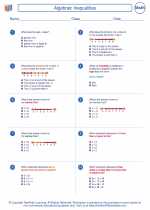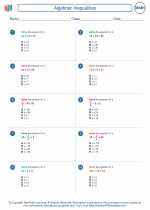Algebraic Inequalities
Introduction to Inequalities
An inequality is a mathematical statement that compares two expressions using one of the inequality symbols: < (less than), > (greater than), ≤ (less than or equal to), ≥ (greater than or equal to), or ≠ (not equal to). Inequalities are used to represent a range of values, rather than a single value.
Linear Inequalities
A linear inequality is an inequality that involves a linear expression, such as ax + b < c or dx - e ≥ f. To solve linear inequalities, you manipulate the inequality expression using similar rules as solving equations, such as adding or subtracting the same value from both sides, multiplying or dividing by a positive or negative number, and graphing the solution on a number line.
Quadratic Inequalities
A quadratic inequality involves a quadratic expression, such as ax2 + bx + c > 0 or dx2 - ex + f ≤ 0. To solve quadratic inequalities, you can use methods like graphing the associated quadratic equation, finding the roots of the equation, or determining the sign of the quadratic expression in different intervals.
Absolute Value Inequalities
An absolute value inequality involves an absolute value expression, such as |ax + b| < c or |dx - e| ≥ f. To solve absolute value inequalities, you consider the cases when the expression inside the absolute value is positive and negative, and apply different rules for each case to obtain the solution set.
Study Guide
Here are the key steps to solve algebraic inequalities:
- Isolate the variable on one side of the inequality, if necessary.
- Use inverse operations to solve for the variable.
- Express the solution set using interval notation or set-builder notation.
- Check the solution by plugging the values back into the original inequality.
When dealing with absolute value inequalities, remember to consider both positive and negative cases and apply the appropriate rules to each case.
Practice solving different types of inequalities and understand the properties of the inequality symbols to master this topic.
Remember, inequalities represent a range of solutions, so the solution set may consist of multiple intervals or values that satisfy the given inequality.
Understanding algebraic inequalities is essential for solving real-world problems and modeling various situations where values are compared or restricted.
.◂Math Worksheets and Study Guides Seventh Grade. Algebraic Inequalities

 Worksheet/Answer key
Worksheet/Answer key
 Worksheet/Answer key
Worksheet/Answer key
 Worksheet/Answer key
Worksheet/Answer key
